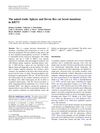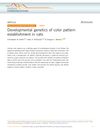Hague: A New Mouse Hair Mutation With an Unstable Semidominant Allele
October 2002
in “
Genetics
”
TLDR A new mouse hair mutation, called hague, is semidominant and unstable, but the exact cause is unknown.
The study identified a spontaneous hair mutation in mice, called hague (Hag), which showed a semidominant inheritance pattern with incomplete penetrance in heterozygotes. The mutation was mapped to the telomeric region of chromosome 15 and was found to be unstable, sometimes shifting to a recessive pattern. Analysis of over 2000 meioses localized the mutation to the keratin 2 complex genes. A physical map of the critical region revealed a 600- to 800-kb segment with 14 genes, 11 of which were expressed in the skin, but none were mutated in the hague mice, leaving the specific causative mutation unidentified.



